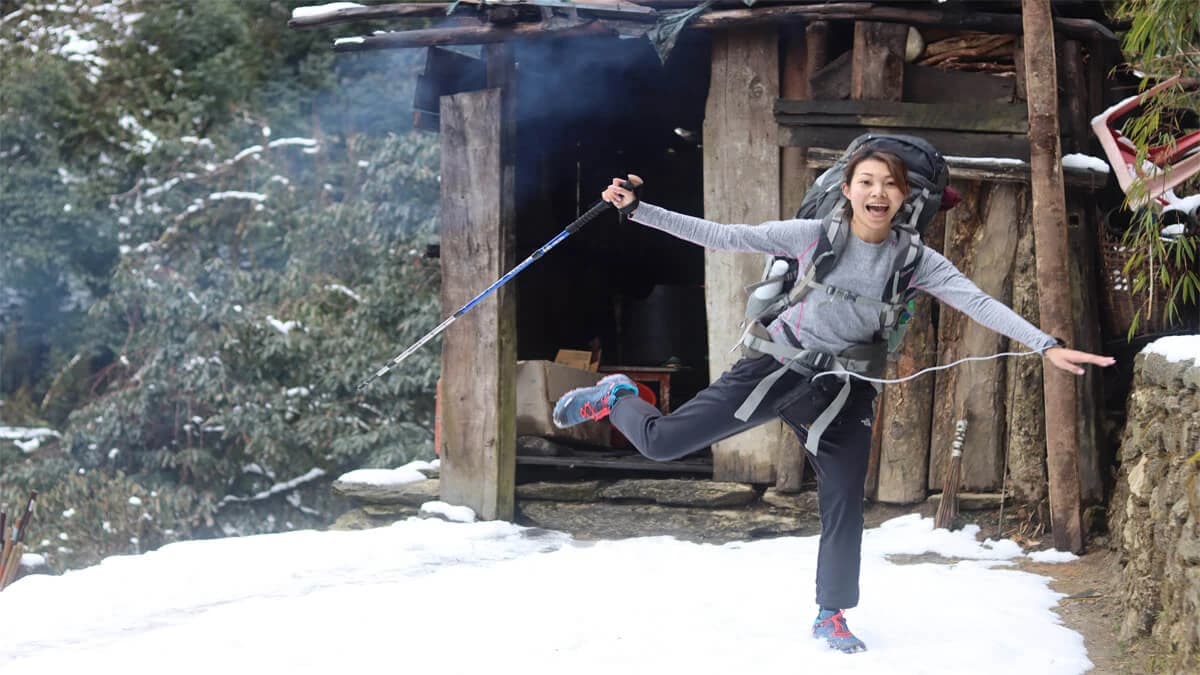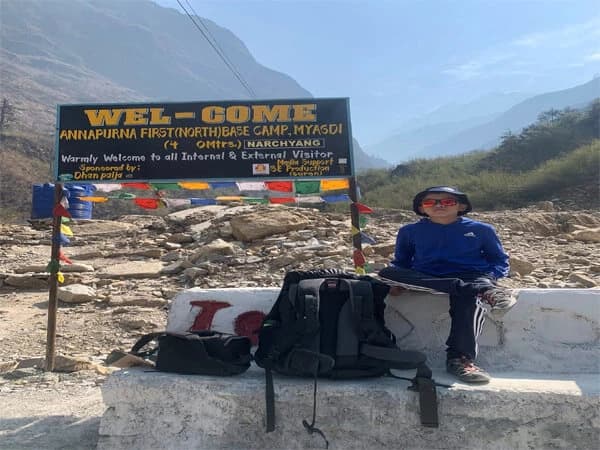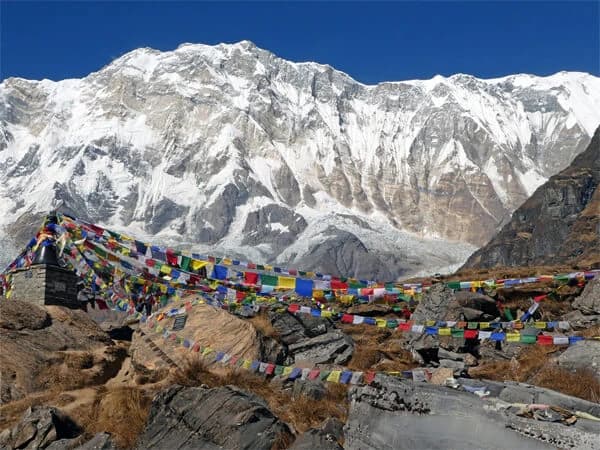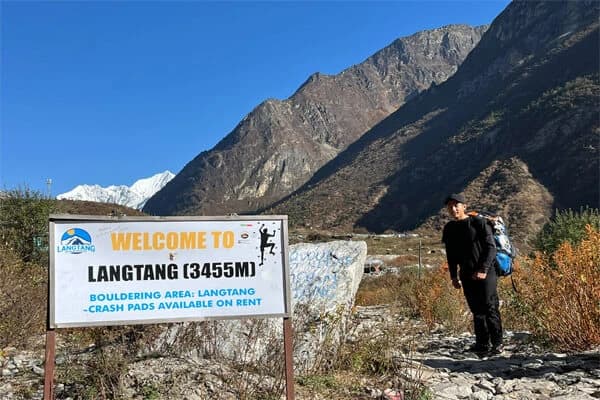The Annapurna Base Camp Trek is rated as moderate in difficulty, making it a great choice for both beginners and experienced trekkers. The trail involves gradual ascents, a few steep sections, and a maximum altitude of 4,130m (13,550ft) at base camp. With well-marked paths, comfortable teahouses, and stunning landscapes all around, it’s an achievable adventure for anyone with reasonable fitness and a sense of adventure.
How difficult is the Annapurna Base Camp Trek?
One of the most sought after trekking destinations of Nepal, Annapurna Base Camp (ABC) is known best for the expansive views of the Annapurna Massif along with the unbarred view of the majestic surrounding mountain ranges. The Annapurna Base Camp trek sees thousands of tourists all year round wanting to have a once in a lifetime experience unlike any other. With the flow of trekkers, comes a wide range of queries one of which is regarding Annapurna Base Camp Trek Difficulty. As much as the views, the difficulty level of Annapurna Base Camp trek trills and attracts the trekkers, thus creating the ultimate wish to acclaim ABC.
How difficult is the Annapurna Base Camp Trek?
During the Annapurna Base Camp Trek, there might be a wide range of difficulties that you might have to face. However, if you follow the advice of your guide and use assistance from your porter, then the trek might be fun as well as easy. Generally, the Annapurna Base Camp trek difficulty is graded as moderate. Moderate in relation to all the other treks in that region and as per the distance and the duration covered. Based on the altitude, the ABC trek is quite modest. Annapurna Base Camp is the highest point of the trek and reached an altitude of 4130m which is relatively lesser than the Annapurna Circuit trekking route with the highest elevation of 5416m at Thorong La pass.
The ABC Trek route has been a popular Nepal Trekking’ destination for a long time now and has many tea houses and hotels along the way. In case of any difficulty, there are chances that you will spot a fellow trekker on the way or will spot a tea house nearby. The area also has cell reception in major stop points. Considering all this makes the ABC trekking trail a lot easier. However, there might be budgetary afflictions in some parts. However, it is always better to be aware, do some research and be careful in the Annapurna region or any other Nepal trekking destination.
There are various factors that cause the Annapurna Base Camp trek difficulty listed below:
Annapurna Base Camp trek difficulty as per distance and duration
Annapurna Base Camp Trek difficulty is generally considered to be at a moderate level. However, it is not as easy as it seems. The trek begins from Nayapul at the altitude of 1070m and then in a couple of days of walking, the trek reaches the maximum altitude of 4130 m at Annapurna Base Camp. The distance that will be covered throughout the ABC trek is 115 km. This calculates to around 20 km of walk per day. Some days, you might even have to walk up to 25 km. But the distance covered each day also relies on the duration of your entire trek. If you wish to complete the entire trek in the standard 7 days then the distance covered per day is 20 km. However, if you wish to extend the days for your ease, then you might have to walk less.
Altitude Sickness difficulty
Altitude is a major factor that causes difficulty in many trek in Nepal. Annapurna Base Camp trek for one is not as difficult in terms of altitude. ABC trek difficulty due to altitude is a factor for those who are not physically fit for the trek and those who have not had any prior experience of trekking in Nepal. ABC itself is the highest altitude of the Nepal trekking trail at 4130m. Altitude sickness is when your body feels uneasy due to the effects of the rise in altitude. This is when there is a low amount of oxygen in the air. Less oxygen in the air means that your brain and your body cannot function well. Acute Mountain Sickness (AMS), is a severe version of Altitude Sickness which is not likely in this kind of trek since the altitude is not that much. Generally, one with Altitude Sickness might experience symptoms like vomiting, tiredness, trouble sleeping, dizziness, and headaches as you reach higher altitudes. There is one easy way to avoid getting altitude sickness, and that is to walk slow and take smaller steps. In addition to that, make sure that you follow the itinerary set by your guide. If you experience signs of altitude sickness then you can take a low dosage of AMS medication after consulting your guide, as a precautionary measure.
Accommodation and Food difficulty
Food and accommodation is an important factor to keep in mind during any trek whether long or short. Proper food and a good night's sleep is essential in keeping your body fit for the next day’s trek. Annapurna Base Camp trekking route is unlike anything you have seen in the peak season. The number of trekkers in a tea house is paramount, so finding a room can be difficult. Nevertheless, your Annapurna Base Camp trek difficulty can be minimal if you have a guide along, Guides generally have good connections with the locals and can pre-book the rooms for you. Food is generally good on the trekking trail. Do not expect an elaborate menu since the options are limited. Drinks usually consist of modest tea or coffee, but in some lodges, you might find hot chocolate if you are willing to pay a little extra.
If you do not want to dehydrate along the way, always remember to carry a refillable water bottle, possibly with water filters. You can fill the water from any clean stream and use some filter and you are good to go.
Annapurna Base camp trekking trail
The Annapurna Base Camp trekking trail can be different in different seasons. The difficulty depends upon the weather as well. Generally in the Spring and Autumn season, the trail doesn’t have heavy snow, so it is relatively easy, However, keep in mind that the Annapurna Base Camp has many ascends and descends. Prepare yourself for what seems like never-ending stairs at some point in Chomrong. If you have muscle ache then you can stop by at the nearest hotel for the night. Don't drain yourself out, since that will only ruin the entire trek.
Prices and Budget management
The prices in trekking destinations of Nepal is generally higher than in the city areas due to inaccessibility. During the peak season, the prices will have soared. Even basic food and lodge facilities will be high. As the altitude increases and the area becomes remote and unreachable, the prices keep getting higher. The reason behind this is because the food has to be brought by manual labor costing a lot. Do not expect an ATM facility once you begin the trek from Nayapul. Hence, you need to have enough hand cash to last throughout the Nepal Trekking and some more. Eating modest food and drinks is one way to keep your budget on track. Also, it is beneficial to hire a local guide for that matter.
Annapurna base camp weather
In the mountainous regions, the weather changes drastically. You need to be prepared for the harshest of the weather. Annapurna Base Camp trek difficulty is also caused by the sudden weather change. During the spring and autumn seasons, the weather is generally pleasant. The weather at lower altitudes is generally sunny or windy. As you head up, the weather might see unprecedented change. Prepare yourself in advance with all the necessities to avoid any sort of discomfort later.
Annapurna Base camp trek difficulty in different seasons
This trek difficulty level is variant upon the different seasons:
Winter seasons Trek to Annapurna Base Camp
The Annapurna Region trek in the Winter season is a different landscape, covered with white glistening snow. Winter season begins in December and lasts until March in Nepal. In the lower altitude, one will observe cold winds but with rays of sunlight. In the upper altitude around Annapurna Base Camp, the trail is covered with huge snow. Nights are colder than the days so you have to keep warm. The temperature might even drop to -17 degrees. The snow is fresh and might mislead trekkers. Even some experienced trekkers lose the way during winters. Chances of Avalanche are another big risk that you take during the winter season. Many trekkers have had fatal ends due to avalanche in the Annapurna Base Camp trail.
Annapurna Base Camp trek in Spring seasons.
Spring season is feasible for going on long trekking in Nepal. Spring begins in March and ends in May. It is one of the busiest seasons and sees a high number of trekkers from around the world. It is the best time for ABC trek since the views are clear and the trail doesn't have heavy snow. However, there might be other difficulties to the trek. The tea houses during this season are packed with tourists and there is difficulty in finding accommodations. Even if you do get a place to stay the night, you will have to wait in long queues to get food and get hot shower facilities.
Annapurna Base Camp trek in summer and monsoon seasons
Summer in the Annapurna region brings heat, humidity, and rain. In the lower altitude, the weather is hot and humid. As you move uphill, there might be chances of sudden rainfall. There are also chances of the mudslide. The trail may get slippery and you can have insect bites. Annapurna Base Camp trek difficulty is seen mostly in this season when you have to deal with leeches and bugs. The sudden rainfall can make the views blurry due to the clouds covering most of the face of Annapurna and Machapuchre.
Annapurna Base Camp trek in Autumn
The autumn season is yet another best time to trek to Annapurna Base Camp. The views are generally majestic. However, there are chances that you might face difficulties during this season due to the huge inflow of internal as well as external tourists. Arranging accommodation is relatively difficult and the trail may be overcrowd with people. It is best advise that you have your guide book the teahouses.
Useful tips on Annapurna Base Camp Trek difficulty:
We at Nepal Trekking Routes advice you to follow these tips to make your Annapurna Base Camp trek easier:
- Maintain your physical health and fitness by exercising regularly a month before the trekking in Nepal. It is generally advise to avoid smoking and alcohol as it lowers stamina for walking long distance
- Do not walk too fast since you may succumb to altitude sickness. Also, do not walk too slow since you may have to spend more days at higher altitude. Walk at a continuous pace.
- There are chances of getting lost in the thick forest and snow, so don’t take the off-beat track
- Drink plenty of water to keep yourself hydrated and eat energy bars to sustain energy during the trek
- If you feel tired and difficulty in walking, extend the trek and stay an additional day
- Always be aware of the symptoms that your body shows in regards to fatigue, headaches, difficulty in breathing. This may eventually cause altitude sickness.
- Always carry a first aid kit or ensure that your guide has a first aid kit in case of medical emergencies
- Use a walking pole or a proper stick which will ease the difficulty in walking in tough trails
- Hire a guide to advise you throughout the trek and also a porter to carry your bags/luggage
Conclusion: Annapurna Base Camp Trek Difficulty
Annapurna Base Camp trek has been classified as a moderate level trekking in Nepal. Nepal Trekking Route makes sure that the difficulties during the Annapurna Base Camp trek is minimize through a proper itinerary, useful tips, facility of experience guides and strong porters. In all regards, the ABC trek is a lifetime experience to remember.







